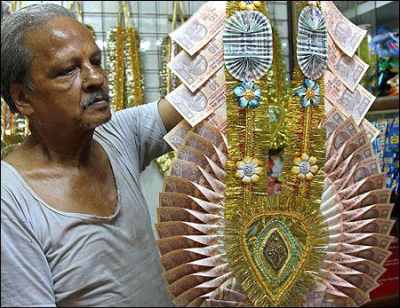
The Indian economy has clearly been on an upward growth path -- from an average annual rise of three to four per cent in the first three decades, growth took a sharper upturn in the eighties.
Over the period 2001-02 to 2009-10, the growth rate was higher than the previous decade by almost two percentage points. In fact, a less than seven per cent rate was registered in just two of the past seven years.
The latest state-wise estimates released last month by the Central Statistical Organisation (CSO) gives data for all states and Union Territories for 2010-11, showing a wide range with seven states growing in double-digits and five at less than seven per cent.
Union Budget 2012-13: Complete coverage...

To begin with, there is a wide diversity in the size and structures of state economies. On the one hand, Maharashtra alone contributes 14 per cent to India's GDP, but on the other, 19 states together contribute 15 per cent.
Maharashtra is followed by Uttar Pradesh, but its share to total GDP is at least seven percentage points lower.
Andhra Pradesh, Tamil Nadu, Gujarat, West Bengal and Karnataka are the other five big states, contributing at least six per cent each, while at the bottom are the north-eastern states, together accounting for little above one per cent of the national GDP. With such diversity in size, comparability among states becomes even more difficult.
Union Budget 2012-13: Complete coverage...

The top-performing states in 2010-11 were Chandigarh, Bihar, Tamil Nadu and Chhattisgarh, all with more than 11 per cent growth in gross state domestic product (GSDP).
These were followed by Delhi, Gujarat and Maharashtra with double-digit growth. Jammu and Kashmir, Manipur, Jharkhand, Nagaland and Andaman and Nicobar Islands grew at less than seven per cent.
The stark difference in the structure of the largest state economies – Maharashtra and Uttar Pradesh – shows in their growth performance over the past few years, with Uttar Pradesh trailing below the national average.
...

According to CSO estimates of GSDP released for 25 states for 2011-12, growth has been the highest in Bihar at 13.13 per cent, an achievement in a year when the national economy has taken a hit.
Bihar has, in fact, turned in double-digit growth consistently since 2008-09, a turnaround from the days of volatile growth. Delhi has also showed high growth, and Puducherry, Chhattisgarh and Goa are the other states with growth higher than 10 per cent this year.
At the other end, lowest growth is recorded in Andaman and Nicobar Islands at 0.7 per cent, while Arunachal Pradesh and Nagaland grew at less than four per cent a year.
Union Budget 2012-13: Complete coverage...

Though growth has slowed this year, among the states whose data has been released so far, the sharpest drop of more than two percentage points has been seen in Arunachal Pradesh, Andhra Pradesh, Karnataka and Tamil Nadu. However, in four states, growth was higher by more than a percentage point -- Assam, Uttarakhand, Goa and Puducherry.
Regional differences will, of course, always exist but uneven growth across the country in the past has led to huge differences in development levels, making it very difficult for some states to catch up.
Indian States Development Scorecard, a weekly feature by Indicus Analytics, focuses on the progress in India and across the states across various socio-economic parameters.
Union Budget 2012-13: Complete coverage